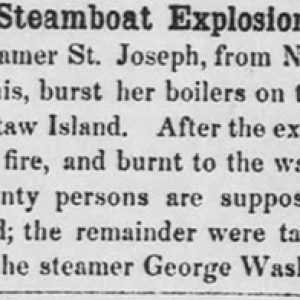calsfoundation@cals.org
St. Joseph [Steamboat]
The St. Joseph was a steamboat that burst a boiler on the Mississippi River on January 23, 1850, resulting in the deaths of between fifteen and twenty passengers and crew members.
The St. Joseph was a 217-ton sidewheel paddleboat built at St. Louis, Missouri, in 1846 that ran a route along the Mississippi between St. Louis and New Orleans, Louisiana.
The St. Joseph was heading up the Mississippi River on January 23, 1850, with a load of passengers—many of whom were immigrants—and cargo when, while apparently racing with the steamboat South America, its larboard boiler burst as the vessel neared the mouth of the Arkansas River. The boiler blew backward, killing a boy and mortally wounding the ship’s second engineer. As desperate passengers and crew dove overboard, the St. Joseph caught fire and ultimately burned to the waterline. The steamboat’s captain, using its yawl to rescue people struggling in the water, called on the captain of the South America to rescue the people still aboard the doomed vessel. Among them was a man named Moore from Missouri who was “mortally wounded. He lingered in great agony for twenty-four hours, having every particle of skin pealed [sic] from his body.”
The St. Joseph’s Captain Baker rescued $3,000 from the ship’s chest and gave it to the clerk of the South America for safekeeping. When he asked for it back the next day so that he could pay his crew, though, the clerk would only give him $800, “claiming the balance for salvage.” When the steamboat got to Memphis, Baker sought legal assistance, and the sheriff seized the South America. When local citizens learned what was happening, many became angry, and the South America’s officers, “being apprehensive of popular vengeance,” returned the money.
While contemporary accounts reported the St. Joseph’s fatalities as being around fifteen or twenty, a later report mentioned three killed or mortally wounded by the boiler explosion and eight or ten drowned.
The South America also would not survive the year, catching fire and burning near New Orleans on December 17, 1850, with around forty dead.
The St. Joseph catastrophe is one of many examples of the dangers of steamboat travel in Arkansas waters in the nineteenth century, when boiler explosions also caused mass casualties on the Car of Commerce in 1828, Rob Roy in 1836, Persian in 1840, J. Wilson in 1853, Sultana in 1865, and Miami in 1866.
For additional information:
“Dreadful Steamboat Explosion.” Middlebury [Vermont] Register, February 12, 1850, p. 3.
Lloyd, James T. Lloyd’s Steamboat Directory and Disasters on the Western Waters. Cincinnati, OH: James T. Lloyd & Co., 1856.
“Steamboat Explosion.” Port Gibson [Mississippi] Herald and Correspondent, February 1, 1850, p. 2.
Way, Frederick, Jr. Way’s Packet Directory. Athens: Ohio University Press, 1983, p. 411.
Mark K. Christ
Central Arkansas Library System


 St. Joseph Steamboat Article
St. Joseph Steamboat Article  St. Joseph Steamboat Article
St. Joseph Steamboat Article 



Comments
No comments on this entry yet.